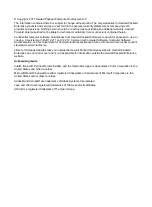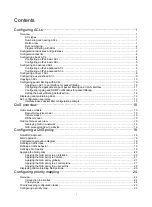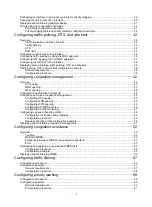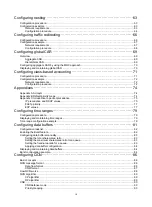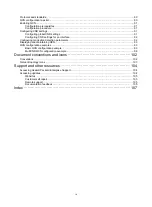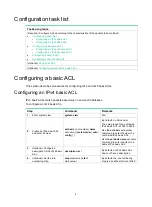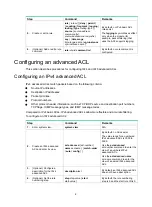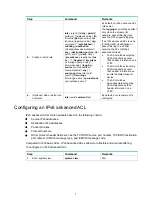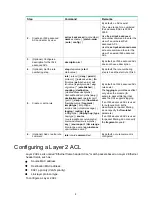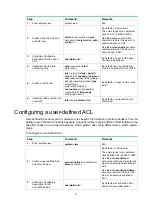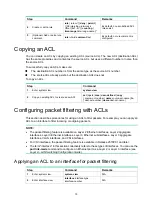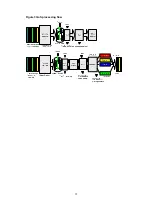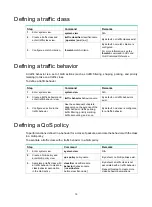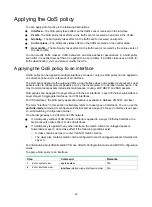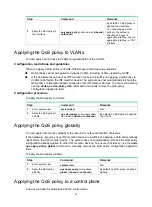
7
Step Command
Remarks
5.
Create or edit a rule.
rule
[
rule-id
] {
deny
|
permit
}
protocol
[ { {
ack
ack-value
|
fin
fin-value
|
psh
psh-value
|
rst
rst-value
|
syn
syn-value
|
urg
urg-value
} * |
established
} |
counting
|
destination
{
dest-address
dest-wildcard
|
any
} |
destination-port
operator
port1
[
port2
] | {
dscp
dscp
|
{
precedence
precedence
|
tos
tos
} * } |
fragment
|
icmp-type
{
icmp-type
[
icmp-code
] |
icmp-message
} |
logging
|
source
{
source-address
source-wildcard
|
any
} |
source-port
operator
port1
[
port2
] |
time-range
time-range-name
|
vpn-instance
vpn-instance-name
] *
By default, no IPv4 advanced ACL
rules exist.
The
logging
keyword takes effect
only when the module (for
example, packet filtering) that
uses the ACL supports logging.
If an IPv4 advanced ACL is used
for QoS traffic classification or
packet filtering in a VXLAN
network, the ACL matches
packets as follows:
•
The ACL matches outgoing
VXLAN packets by outer
IPv4 header information on a
VTEP.
•
The ACL matches incoming
VXLAN packets by outer
IPv4 header information on
an intermediate transport
device.
•
The
ACL
matches
de-encapsulated incoming
VXLAN packets by IPv4
header information on a
VTEP.
6.
(Optional.) Add or edit a rule
comment.
rule
rule-id comment
text
By default, no rule comment is
configured.
Configuring an IPv6 advanced ACL
IPv6 advanced ACLs match packets based on the following criteria:
•
Source IPv6 addresses.
•
Destination IPv6 addresses.
•
Packet priorities.
•
Protocol numbers.
•
Other protocol header fields such as the TCP/UDP source port number, TCP/UDP destination
port number, ICMPv6 message type, and ICMPv6 message code.
Compared to IPv6 basic ACLs, IPv6 advanced ACLs allow more flexible and accurate filtering.
To configure an IPv6 advanced ACL:
Step Command
Remarks
1.
Enter system view.
system-view
N/A
Summary of Contents for FlexFabric 5940 Series
Page 23: ...17 Figure 3 QoS processing flow ...
Page 84: ...78 Figure 26 MPLS label structure ...
Page 91: ...85 Switch burst mode enable ...


